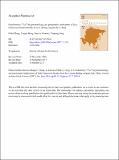Files in this item
Geochemistry, 40Ar/39Ar geochronology, and geodynamic implications of Early Cretaceous basalts from the western Qinling orogenic belt, China
Item metadata
| dc.contributor.author | Zhang, Feifei | |
| dc.contributor.author | Wang, Yuejun | |
| dc.contributor.author | Cawood, Peter.A. | |
| dc.contributor.author | Dong, Yunpeng | |
| dc.date.accessioned | 2018-10-16T23:47:50Z | |
| dc.date.available | 2018-10-16T23:47:50Z | |
| dc.date.issued | 2018-01 | |
| dc.identifier | 251388776 | |
| dc.identifier | 7cde6383-c285-4ea4-af72-f54132e234f1 | |
| dc.identifier | 85033693285 | |
| dc.identifier | 000418974400006 | |
| dc.identifier.citation | Zhang , F , Wang , Y , Cawood , P A & Dong , Y 2018 , ' Geochemistry, 40Ar/39Ar geochronology, and geodynamic implications of Early Cretaceous basalts from the western Qinling orogenic belt, China ' , Journal of Asian Earth Sciences , vol. 151 , pp. 62-72 . https://doi.org/10.1016/j.jseaes.2017.10.018 | en |
| dc.identifier.issn | 1367-9120 | |
| dc.identifier.other | RIS: urn:37BB08739CC54914205EEA00BA4DECC9 | |
| dc.identifier.uri | https://hdl.handle.net/10023/16246 | |
| dc.description | This work was financially supported by Chinese National Natural Science Foundation (Grants. 41421002, 41302176 and 41190074), National Basic Research Program of China (2016YFC0600303 and 2014CB440901) and Foundation of Shaanxi Educational committee (14JK1760). P.A. Cawood acknowledges support from Australian Research Council (Grant FL160100168). | en |
| dc.description.abstract | The Qinling-Dabie orogenic belt was formed by the collision of the North and South China Cratons during the Early Mesozoic and subsequently developed into an intracontinental tectonic process during late Mesozoic. Field investigations identified the presence of late Mesozoic basalts in the Duofutun and Hongqiang areas in the western Qinling orogenic belt. The petrogenesis of these basalts provides an important constraint on the late Mesozoic geodynamics of the orogen. The representative basaltic samples yield the 40Ar/39Ar plateau age of about 112 Ma. These samples belong to the alkaline series and have SiO2 ranging from 44.98 wt.% to 48.19 wt.%, Na2O+K2O from 3.44 wt.% to 5.44 wt.%, and MgO from 7.25 wt.% to 12.19 wt.%. They demonstrate the right-sloping chondrite-normalized REE patterns with negligible Eu anomalies (1.00-1.10) and PM-normalized patterns enriched in light rare earth element, large ion lithophile element and high field strength element, similar to those of OIB rocks. These samples additionally show an OIB-like Sr-Nd isotopic signature with εNd(t) values ranging from +6.13 to +10.15 and initial 87Sr/86Sr ratios from 0.7028 to 0.7039, respectively. These samples are geochemically subdivided into two groups. Group 1 is characterized by low Al2O3 and high TiO2 and P2O5 contents, as well as high La/Yb ratios (>20), being the product of the high-pressure garnet fractionation from the OIB-derived magma. Group 2 shows higher Al2O3 but lower P2O5 contents and La/Yb ratios (<20) than Group 1, originating from asthenospheric mantle with input of delaminated lithospheric component. In combination with available data, it is proposed for the petrogenetic model of the Early Cretaceous thickened lithospheric delamination in response to the asthenospheric upwelling along the western Qinling orogenic belt. | |
| dc.format.extent | 1348996 | |
| dc.language.iso | eng | |
| dc.relation.ispartof | Journal of Asian Earth Sciences | en |
| dc.subject | Basaltic rocks | en |
| dc.subject | Early Cretaceous | en |
| dc.subject | Geochemical signatures | en |
| dc.subject | Lithospheric delamination | en |
| dc.subject | Western Qinling orogenic belt | en |
| dc.subject | GE Environmental Sciences | en |
| dc.subject | QE Geology | en |
| dc.subject | QD Chemistry | en |
| dc.subject | DAS | en |
| dc.subject.lcc | GE | en |
| dc.subject.lcc | QE | en |
| dc.subject.lcc | QD | en |
| dc.title | Geochemistry, 40Ar/39Ar geochronology, and geodynamic implications of Early Cretaceous basalts from the western Qinling orogenic belt, China | en |
| dc.type | Journal article | en |
| dc.contributor.institution | University of St Andrews. School of Earth & Environmental Sciences | en |
| dc.contributor.institution | University of St Andrews. Scottish Oceans Institute | en |
| dc.contributor.institution | University of St Andrews. St Andrews Isotope Geochemistry | en |
| dc.identifier.doi | https://doi.org/10.1016/j.jseaes.2017.10.018 | |
| dc.description.status | Peer reviewed | en |
| dc.date.embargoedUntil | 2018-10-17 |
This item appears in the following Collection(s)
Items in the St Andrews Research Repository are protected by copyright, with all rights reserved, unless otherwise indicated.

